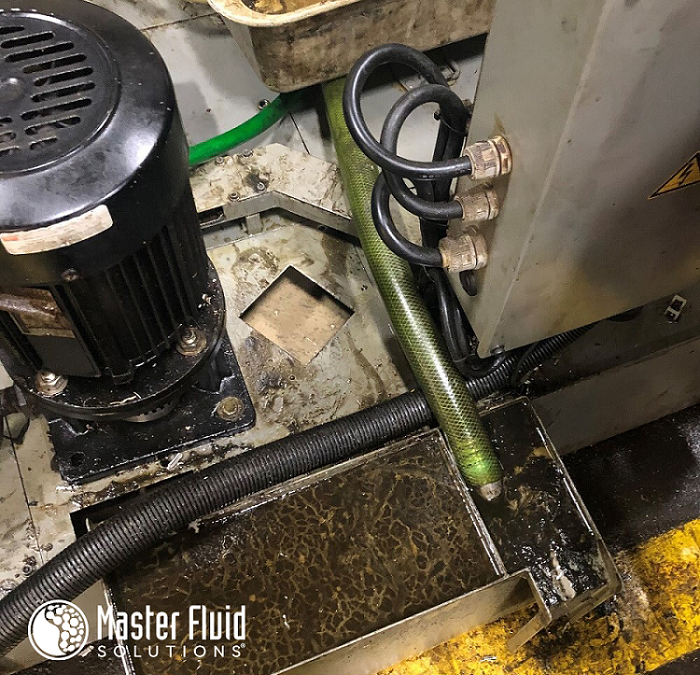Expired metalworking fluid doesn’t just smell bad; it can cause serious harm to employees and the company’s bottom line. Upwards of 1.2 million workers use metalworking fluids and work-related asthma (WRA) can be one of the top concerns. It’s important to keep workers safe and healthy, not only for cost savings but also for their morale.
Metalworking fluid that’s past its prime can also damage machinery and the metal being machined. As a result, shops are forced to throw away expensive sheets of metal. They also need to shut down production and incur expensive repair costs.
Before you notice an increase in worker complaints or machinery problems, evaluate your fluid to make sure it’s functioning properly. Here are five questions to ask to determine if the shop needs a full fluid change:
1. Are Your Employees Complaining of Skin or Lung Irritation?
If you’re using a high-quality fluid and managing it properly, dermatitis and lung issues should be very rare on the floor. But if more workers than usual are reporting symptoms, it could be due to using the wrong metalworking fluid or improper maintenance, which could require a full change-out with a new fluid.
Even with the right fluid, employees can still have problems if there’s too high of a concentration of the fluid-to-water ratio. An unstable emulsion, contamination, and additives being used improperly can adversely affect workers. Once you do change your fluid, you’ll need to pay attention to these factors.
2. Is Excess Tramp Oil Present?
When the lubricant seeps into the coolant, tramp oil forms. In a few cases, it can be removed without a full clean-out. Free-floating tramp oil can be skimmed off the surface or removed by absorbing it with an oil mat, then using a shop vacuum. When machines are idle, you skim off dispersed coolant as it coalesces on top.
However, emulsified tramp oil is oil that has bonded with the coolant. If it’s not removed, it can cause excessive oil mist and smoke, which can potentially raise operator complaints. It can also result in bacteria formation, which releases smelly gasses into the air, as well as corrodes machinery and parts. Removing emulsified tramp oil requires using a centrifuge. However, when excess tramp oil is present, changing out the coolant may be easier.
3. Does the Coolant Smell Bad or Appear Discolored?
Contaminated fluid, or fluid with bacterial formation, usually emits a foul odor or is a strange color. This often happens if the coolant is past due for a complete change-out or hasn’t been well-maintained with regular sump cleanings and prompt tramp oil removal, or if the workers are using the sumps as a trash can substitute. If it appears that the coolant is too contaminated to clean, it may be time to clean out the sump and recharge it with fresh fluid.
4. Are Your Tools Giving Out?
If your tools aren’t lasting as long as they once did, that can mean the coolant isn’t being filtered properly and metal fines are making their way into it. Eventually, this will create sludge on the bottom of the sump and result in bacterial growth, which is just one variable that affects tool life. If you catch this early enough, you can likely filter out the fines. But if you wait too long, you may need a full change-out.
5. Are Machines Rusty?
When the machines start rusting, it could be another sign that you’re using the wrong coolant. Rust could be forming on chucks, vises, ball screws, and even on the metal being machined. In this case, it’s worth investigating other types of coolants that may be more compatible with the machines, metals, and shop applications.
Remember: Fluid Life Is Finite
While metalworking fluid won’t last forever, proper maintenance can help extend its life. However, when the fluid isn’t performing as well as it should and employees start reporting issues with the coolant starting to smell, or tools not having the expected lifespan, it may need to be changed out. Often, regular maintenance and addressing issues promptly can extend the fluid’s lifespan. For example, removing tramp oil as soon as it forms by skimming it off the surface helps prevent bacteria growth.
For more information on the First Charge No Charge coolant offer, which can help you restart your facility after closure with a full charge of fresh coolant, contact Master Fluid Solutions® at +1 800-537-3365 or email us at [email protected].

